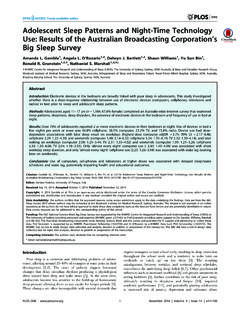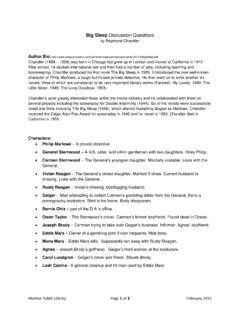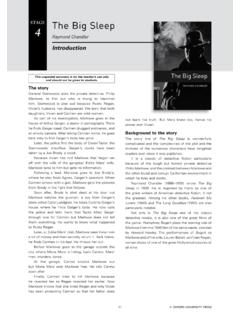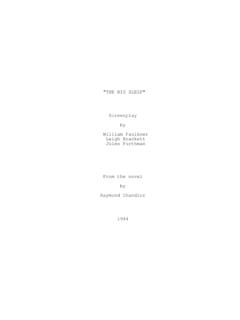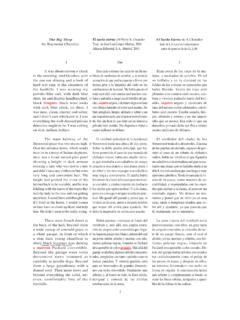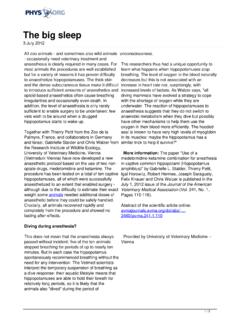Transcription of Raymond Chandler: Breaking the Norms of the Detective Genre
1 1 Balazs BiroRaymond chandler : Breaking the Norms ofthe Detective GenreMy theory was that readers just thought that they cared aboutnothing but the action; that really although they didn t know it,they cared very little about the action. The thing they reallycared about, and that I care about, was the creation of emotionthrough dialogue and chandler is revered as one of the most influential crime writersin American literature. His novels about private eye Philip Marlowe, theidealistic and lonely defender of Los Angeles of the 1930s and 1940s,broke the Norms of the conventional Detective and mystery story.
2 Previousdetective stories were constructed to follow the classic pattern establishedby Edgar Allan Poe and Sir Arthur Conan Doyle, with the application of aheroic puzzle-solving Detective like Poe s C. Auguste Dupin2 or Doyle sSherlock Peter J. Rabinowitz, for instance, claims that the de-tective story is a highly conventionalised Genre , with specific rules whichhave been accepted by readers, critics and writers alike. 4 chandler how-ever, approached his stories on another level by creating a realistic portraitof a corrupted city with perverted ideals that subsequently influenced theway the entire Genre was used.
3 He introduced a style and themes thatclearly violated the Norms and conventions of the Genre of Detective fictionand also exposed less savoury aspects of society. These concerns takeChandler out of the precise confines of the cerebral puzzle of, for examplethe pedantic Hercule By sharply questioning people s normativeperception of the society around them, chandler violates the rules of thedetective novel on a grand scale. The traditional Detective story had up to 1 Raymond chandler , as cited in Frank MacShane: The Life of Raymond : 1986, See e.
4 G. Edgar Allan Poe s The Murders in the Rue See e. g. Sir Arthur Conan Doyle s The Red Peter J. Rabinowitz: Rats Behind the Wainscoating: Politics, Convention and Chan-dler s The Big sleep . J. K. van Dover (ed.): The Critical Response to Raymond Chan-dler. Westport: 1995, 224 245 (119).5 See e. g. Agatha Christie s Appointment with point mainly dealt with one layer of society, the upper class, where themurders committed tended to be elaborately contrived. chandler saw pastthe problems of limiting his writing to a certain social layer and gavemurder back to the kind of people that commit it for reasons, not just toprovide a corpse; and with the means at hand, not hand wrought duelingpistols, curare and tropical fish.
5 6As this essay will show, chandler set his stories in a realistic environ-ment but simultaneously introduced a narrative reminiscent of Gothic sto-rytelling, with its portrayal of knighthood and chivalry. Marlowe became aknight in a society where a code of honour did not apply, and chandler sprivate eye is therefore not only an anachronism in the Detective Genre butalso deviates from our expectations concerning the heroic. chandler thusparadoxically violates both the Norms of the Detective Genre and defamil-iarizes our view of the society he is describing. To show the levels and sub-levels where these violations occur and to show their effect, I will closelyexamine both chandler s plot construction and characterisation by lookingat his two first novels: The Big sleep and Farewell, My initial critical reception of The Big sleep was particularly concernedwith chandler s plot and structure.
6 Expecting the classic whodunnit typeof Detective story, reviewers and fellow authors were caught off-guard andconfused by chandler s seemingly structureless plot and use of suddenturns of events. However, some critics managed to see chandler s work forwhat it truly was: [ chandler ] deals with a [..] varied assortment of per-sons. He has a great sense of probability. 8 Others, like mystery writer J. , never looked beyond the previously established Norms and regardedChandler s style as muddy writing and bad construction. 9In The Simple Art of Murder, chandler attacked the traditional detectivestory and its plot-oriented construction.
7 Instead of trying to produce aflawless plot, chandler favoured style and characterisation and wrote that the coolheaded constructionist does not also come across with lively char-acters, sharp dialogue, a sense of pace. 10 He continued by clearly defininghis own point of view in the matter: The fellow who can write you a vivid 6 Raymond chandler : The Simple Art of Murder. New York: 1988, Raymond chandler : The Big sleep . London: 1970, hereafter referred to as TBS, andFarewell, My Lovely. The Raymond chandler Omnibus. New York: 1980, hereafter re-ferred to as Somerset W.
8 Maugham: The Vagrant Mood. London: 1952, van Dover (ed.): The Critical Response to Raymond chandler , chandler : The Simple Art of Murder, colourful prose simply will not be bothered with the coolie labour ofbreaking down unbreakable alibis. 11 chandler s essay generated enormous response in the Detective andmystery writing community, resulting in heavy criticism of his violation ofthe mystery writers code of honour . J. D. Carr thought chandler naiveand disliked his attack on tradition in the name of realism,12 and said that if to some restraint, he [ chandler ] could add the fatigue of constructionand clues [.]
9 ] then one day he may write a good novel. 13 Isaac Anderssonof The New York Times Book Review also continued to be troubled byChandler s plotting, condemning his over-reliance on luck and did not disagree with those who criticised his plotting, but hisdislike of deductive Detective stories made him disparage plots: The plotthickens and the people become mere names. 15 Concentrating on style,pace and characters instead, his storytelling works rather on the psycho-logical level, where the action and the progress of the novel are driven bythe characters and not by the events.
10 Frederic Jameson claims that the resultof this formal change is that the Detective no longer inhabits the atmo-sphere of pure thought, of puzzle-solving and the resolution of a set ofgiven elements. 16 It could be said that chandler undermines the lifelessand mechanical puzzle-story approach to the Detective novel, and re-places the former with a formula based on a lively style deeply rooted s valorisation of realism made him regard the classic detectivestory as ambiguous, in terms of the message it conveyed. As FrankMacShane explains: chandler considered the traditional deductive novelbasically dishonest because it relied on esoteric information or gave mis-leading information.
